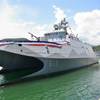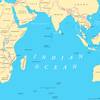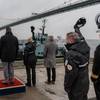PACFLT Hosts Senior Leaders Course
Senior military leaders from 14 nations gathered at U.S. Pacific Fleet (PACFLT) headquarters here in Hawaii for the Naval War College Combined Force Maritime Component Commander (CFMCC) Flag Officer Course Feb. 5-11.
The 27 CFMCC participants came from Australia, Bangladesh, Canada, Chile, France, India, Indonesia, Japan, Peru, Republic of the Philippines, Republic of Korea, Singapore, Sri Lanka, and the United States.
"This course is one of the most important international venues the U.S. Navy hosts and directly supports our strategic rebalance to the Indo-Asia-Pacific," said Adm. Harry B. Harris Jr., commander of U.S. Pacific Fleet. "It provides big and realizable dividends for all participating nations by strengthening regional partnerships and improving operational effectiveness to address our common maritime challenges. The juice is well worth the squeeze."
Chief of Naval Operations (CNO) Adm. Jonathan Greenert told CFMCC participants, "This is a unique situation; they didn't have such a thing when I was coming up. Grasp this opportunity," said Greenert, who stopped in Hawaii on his way to visit Australia and New Zealand. "The fellowship that you will start developing here enables us and other countries to get aligned. Personal relations make it happen. You will never have enough resources like this again."
The Naval War College facilitated the weeklong course, and this was the ninth annual CFMCC hosted by PACFLT since 2007.
"With the U.S. Navy presence in the Asian maritime theater, it is important to have CFMCC at PACFLT," said retired Vice Adm. Yoji Koda, a facilitator from the Naval War College and former commander in chief of the Japan Maritime Self-Defense Force Fleet. "It is essential to give the countries aligned with the U.S. a better understanding of how PACFLT conducts business."
The participants heard lectures on maritime security and took part in open-forum panel discussions facilitated by subject-matter experts to foster a better understanding of the various perspectives involved in a combined force.
"It's an honor to be here at CFMCC. This is a good opportunity to make friends with all the countries here," said Rear Adm. Young-suk Kim, Republic of Korea Navy, deputy commander Republic of Korea First Fleet. "This is also a great opportunity to better understand PACFLT and the U.S. Navy, its history at Pearl Harbor and how huge it is."
Rear Adm. Lisa Franchetti, commander of U.S. Naval Forces Korea, echoed Kim's sentiments.
"CFMCC gives us the opportunity to build personal relationships with our partners, improve cooperation across the theater, and learn from the experience of the senior facilitators," Franchetti said. "The course provides great exposure to senior leader views, such as the CNO, PACFLT commander and Marine Forces Pacific commander. We also get to hear the partners and facilitator's perspectives on the Indo-Asia-Pacific and their thoughts on how to effectively organize for a combined operation."
The value of these cooperative relationships has been proven in recent months when the U.S. Navy operates with partners and allies during disasters such as responding to Typhoon Haiyan in the Philippines or in the search for missing airliners.












